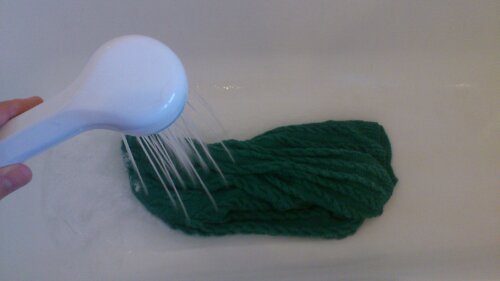I have already outlined how to rescue acrylic knits from a hot spin cycle, but I did not think that the method could save anything more intricate than my garter blanket.
How wrong I was! Using the same methods, I have rescued a lovely handknit cabled cardigan my Nan accidentally put on a hot wash. I took some pictures and thought I’d share, as I now have access to a bath, which made the whole process a lot more streamlined and photogenic.
The primary problem with the cardigan was the squeakiness, which was beyond even my tolerance, and the tightness of the partially melted fibres. The first thing to do was to soak, so I mixed some lukewarm water with shampoo and hair conditioner (might as well clean at the same time!). Then I gently pushed the unbuttoned cardigan into the water and left it for 10 to 15 minutes.
When thoroughly soaked, I poured neat conditioner onto the fabric near the surface and massaged it gently into the wool, rubbing in short motions from collar to hem and back again. Then I opened the cardigan up, applied more conditioner and rubbed it into the other side of the fabric (the inside of the cardigan), finally I rolled the whole cardigan over and applied and massaged into the back.
Then, after a five minute soak, I put my palm on the fabric, fingers spread, and agitated the stitches from side to side. I did this all over, to every square foot of fabric, for about 20 minutes in total. Then, 5 minutes more soaking, and a lukewarm shower to rinse out excess hair products.
Then, I rolled it in a towel to squeeze out excess water, and lay it out flat to dry. The result is a much softer, more relaxed fabric that is significantly more comfortable to wear, and one which feels a lot closer to the fluffy fabric that went in the fateful washing machine than the cling film that came out.



